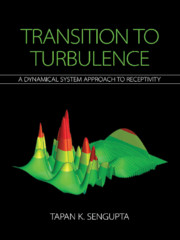Book contents
- Frontmatter
- Dedication
- Contents
- Preface
- 1 Receptivity, Instability, and Transition: A Perspective
- 2 Dynamical System Theory and Role of Equilibrium Flows
- 3 Fundamentals of Scientific Computing
- 4 Instability and Transition
- 5 Receptivity Analysis: Relation with Instability Experiments
- 6 Dynamical System Theory of Linear Receptivity
- 7 Nonlinear, Nonparallel Effects on Receptivity, Instability, and Transition
- 8 Three-Dimensional Routes of Transition to Turbulence
- 9 Receptivity to Free Stream Excitation: Theory, Computations, and Experiments
- 10 Nonlinear Receptivity Theories: Hopf Bifurcations and Proper Orthogonal Decomposition for Instability Studies
- 11 Mixed Convection Flow
- 12 Baroclinic Instability: Rayleigh–Taylor Instability
- 13 Coherent Structure Tracking in Transitional and Turbulent Flows
- 14 The Route of Transition to Turbulence: Solution of Global Nonlinear Navier–Stokes Equation
- References
14 - The Route of Transition to Turbulence: Solution of Global Nonlinear Navier–Stokes Equation
Published online by Cambridge University Press: 16 February 2021
- Frontmatter
- Dedication
- Contents
- Preface
- 1 Receptivity, Instability, and Transition: A Perspective
- 2 Dynamical System Theory and Role of Equilibrium Flows
- 3 Fundamentals of Scientific Computing
- 4 Instability and Transition
- 5 Receptivity Analysis: Relation with Instability Experiments
- 6 Dynamical System Theory of Linear Receptivity
- 7 Nonlinear, Nonparallel Effects on Receptivity, Instability, and Transition
- 8 Three-Dimensional Routes of Transition to Turbulence
- 9 Receptivity to Free Stream Excitation: Theory, Computations, and Experiments
- 10 Nonlinear Receptivity Theories: Hopf Bifurcations and Proper Orthogonal Decomposition for Instability Studies
- 11 Mixed Convection Flow
- 12 Baroclinic Instability: Rayleigh–Taylor Instability
- 13 Coherent Structure Tracking in Transitional and Turbulent Flows
- 14 The Route of Transition to Turbulence: Solution of Global Nonlinear Navier–Stokes Equation
- References
Summary
Introduction
Turbulence continues to be a largely unsolved problem of physics, despite accurate numerical results available for some canonical problems. One of the dominant approaches in studying turbulence is nonlinear dynamics, sharing certain universal properties of fully developed turbulence. The other approaches include studies where turbulence is traced as a receptivity problem starting from the excitation of an equilibrium flow by input disturbances and the disturbances propagate via multiple instabilities accounting for the overall growth processes. This latter approach has been the one followed in this book so far. In Figure 2.1, a schematic of flow transition indicated the dynamical system approach as a possible route. Two other such roadmaps are now presented in Figure 14.1, and these are from [90] and [385], both of which classify transition routes based on the amplitude of excitation only. According to Saric et al. [385] the amplitude of input excitation increases for routes followed along A to E in Figure 14.1. In the other road-map, Cherubini et al. [90] also cites the primary instability associated with TS waves as due to low amplitude excitation, as in the path A due to [385] with routes are somewhat similar in these maps. In explaining the relation between instability experiments and receptivity analysis in Chapter 5, it is now clear that TS wave or wave-packet is strictly an artifact of experiments created to validate spatial instability theory. Discussion in Chapter 6 also establishes that transition can be initiated in many ways, with harmonic wall excitation (as in [405]) as just one of the many routes described in Chapter 6. The classification of a route as bypass transition is therefore an anachronism, as the original connotation of it in [298, 364], was absence of TS wave or wave-packet in any route being the rule (and not exceptional cases) for the canonical flow past zero pressure gradient boundary layer. The same can be said about the transient growth processes, which are marked as routes B, C and D in Figure 14.1(a) due to spanwise modulation, mean flow distortion or due to some bypass route - as one of the many possibilities whose generic route happens to be the spatio-temporal route espoused correctly since the necessary approaches developed in [418] and demonstrated in [34, 451, 452, 508, 509] for both two- and three-dimensional transition routes for wall excitation.
- Type
- Chapter
- Information
- Transition to TurbulenceA Dynamical System Approach to Receptivity, pp. 541 - 584Publisher: Cambridge University PressPrint publication year: 2021



